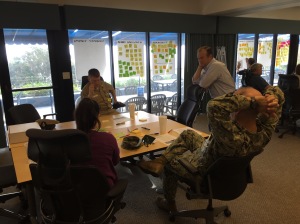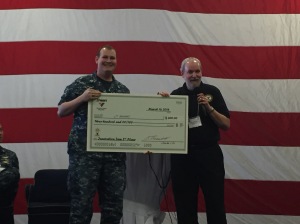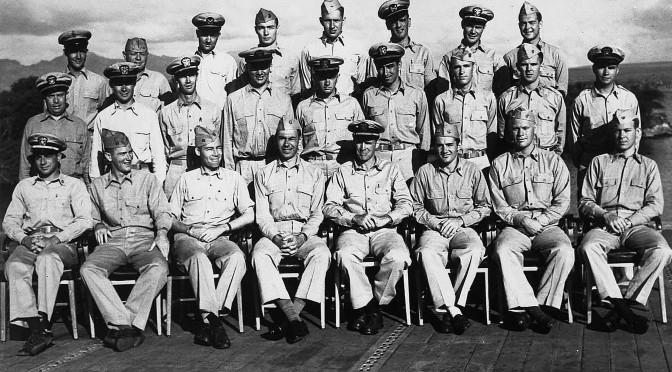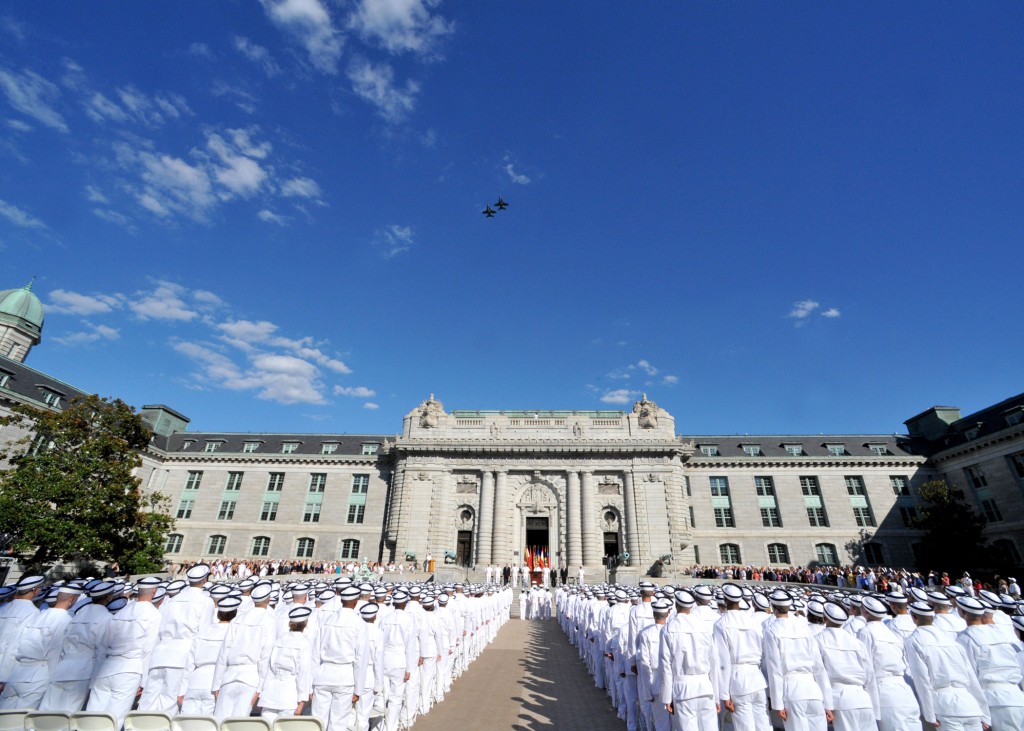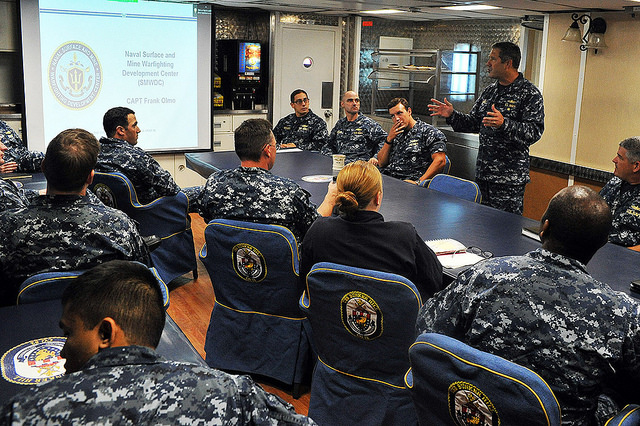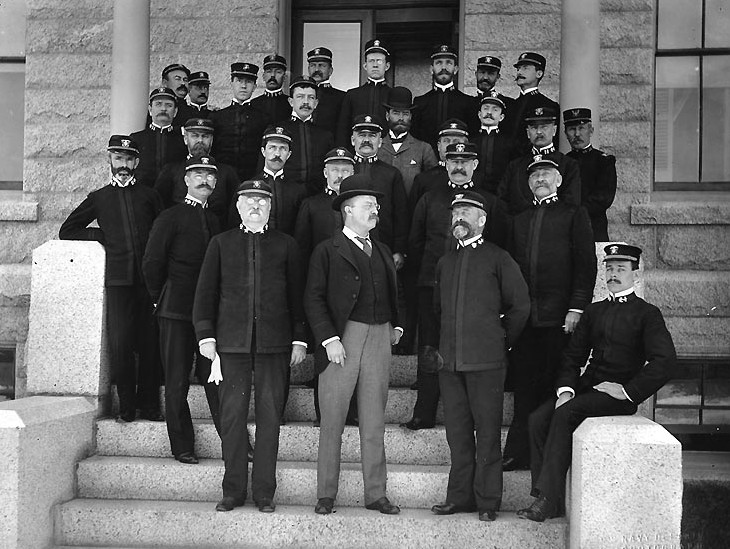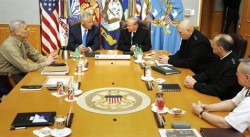This piece was originally published by Small Wars Journal and is republished with permission. Read it in its original form here.
By Robert P. Callahan, Jr.
The phrase “best and brightest” is frequently used but ambiguously defined. Secretary of Defense Ash Carter’s Force of the Future aims to recruit and retain this group, but it fails to define who the best and brightest are. Many proposed personnel reforms do the same thing. Doctrinal and popular sources define which officers are the Army’s best and which are its brightest. These sources suggest that the Army’s best and brightest officers form two almost completely independent groups. The best officers succeed in traditional leadership positions, the brightest officers leverage their participation in Broadening Opportunity Programs to attempt to improve the Army, and the best and brightest do both. The firmly defined career track of the Army’s best and the Army’s up-or-out policy combine to prevent the best and the brightest from overlapping. A number of reforms have been proposed to address this state of affairs, but recent reports suggest that the Army’s policies will not change.
Setting the Stage
During late February 1991, Captain Herbert McMaster led Eagle Troop, 2nd Squadron, 2nd Armored Cavalry Regiment (ACR) east across the deserts of Kuwait during Operation Desert Storm. Eagle Troop was ordered to the 70th easting (a measure of distance east or west) on the afternoon of February 26th, and their advance led directly into a village heavily defended by Iraqis. After engaging the Iraqis and bypassing the village to the north, CPT McMaster’s soldiers decisively engaged a dug-in Iraqi position on the back slope of a ridge. Weaving through minefields, clearing bunkers, and peppering the unprotected rears of Iraqi tanks, Eagle Troop wiped out the Iraqi position. During the course of these actions, Eagle Troop had moved beyond the 70th easting to the 73rd easting. When McMaster’s executive officer radioed a reminder that the 70th easting was the limit of advance, McMaster replied, “I can’t stop. We’re still in contact. Tell them I’m sorry.”[i] McMaster was awarded the Silver Star, the Army’s third highest award for bravery, for his initiative and the successes of Eagle Troop.
Following Desert Storm, McMaster rose steadily through the ranks, commanding 1st Squadron, 4th Cavalry Regiment and the 3rd ACR. Then Colonel McMaster deployed to Iraq with 3ACR in 2005 and 2006. Before its deployment, McMaster replaced a typical National Training Center rotation, which would have closely resembled then CPT McMaster’s experiences at 73 Easting nearly 15 years earlier, with innovative language and cultural training, which even incorporated Arab-Americans role-playing as Iraqi locals. 3ACR put this training to use while clearing Tal Afar, Iraq in 2005 and 2006. At the outset of this effort, Tal Afar was a training base for foreign fighters and home to cells from Al-Qaeda, Ansar Al-Sunna, and former Baathist elements. 3ACR began pushing into Tal Afar on September 2nd, 2005 and successfully cleared the city after overcoming some heavy resistance. 3ACR’s cavalrymen and a battalion of paratroopers from the 82nd Airborne then set out to keep the anti-government forces from retaking the city. These cavalrymen and paratroopers set up a network of small outposts throughout the city and they stayed for months, thereby convincing the locals that the American military and, by extension, the Iraqi government was there to stay. Violent incidents became less frequent and less deadly, and the 3ACR’s actions were heralded as proof that “individuals and units within the Army could learn and adapt on their own.”[ii]
Although McMaster’s career may seem prototypical, the years between his commands in the Middle East and his conduct as 3ACR’s commander marked McMaster as an unusual officer. McMaster taught history at West Point during the mid-1990s, earned a PhD in history from the University of North Carolina, and challenged the conventional wisdom that the military leadership was blameless for the conduct of the Vietnam War in the 1997 Dereliction of Duty, based on his dissertation. Despite these academic and professional successes, McMaster was passed over twice for promotion to brigadier general. Contemporary accounts suggest that it took bringing General David Patraeus, then the commander in Iraq, back to the United States to chair the 2008 brigadier general promotion board for McMaster to be selected for promotion.[iii] When the 2008 brigadier general selections were announced, Slate trumpeted, “Finally, the Army is promoting the right officers.”[iv] According to some commenters, McMaster’s promotion to brigadier general by exception proved the rule that the Army disdains innovative officers.[v] As these commenters tell it, the Army will face an unknown threat in the future, and stifling innovative officers, such as McMaster, will have negative consequences on the future battlefield.[vi]
Meeting the Future Head on
This argument is one of many that conclude that the Army’s current personnel policies, for whatever reason, are setting the Army up for failure.[vii] Secretary of Defense Ash Carter’s Force of the Future, an initiative focused on recruiting and retaining the people our country needs “to serve and defend our country in the years to come,” is intended to prevent such a situation from occurring.[viii] During a speech introducing the initiative, Secretary Carter stated that the military is committed to recruiting America’s “best and brightest” to serve as soldiers, sailors, airmen, and Marines, and that America will need its best and brightest to serve our country in order to meet the challenges of the future.
Perhaps the Force of the Future is just in time. Some people feel that the US Army has been losing its best and brightest since at least 2007.[ix] Others disagree, instead arguing that the best and brightest officers remain in uniform for a full career.[x] What both groups agree on is that there is some group of officers who are the Army’s best and brightest. Unfortunately, neither group defines who these best and brightest officers are. According to Secretary Carter, “college and higher learning are encouraged because we need our sailors, soldiers, airmen, and Marines to be the best and the brightest.”[xi] Secretary Carter’s logic suggests that the best and the brightest are the college educated. However, educational attainment is of limited use as a discriminator since effectively every active duty commissioned officer is required to hold a bachelor’s degree. Therefore, we need to understand who our best and brightest officers are if we are going to examine how our personnel system influences the military service of these officers.
Examining the relationship between the Army’s best officers and its brightest officers offers a path towards gaining such an understanding, and hopefully we can discover which of the following three statements is true: first, all of the Army’s best officers are also its brightest officers, second, some of the Army’s best officers are also its brightest officers, or third, the Army’s best officers and brightest officers are two entirely independent groups. ADRP 6-22 Army Leadership and the Officer Evaluation Report (OER) define the best Army officers, and both Army regulations and popular discourse can be used to characterize the brightest Army officers. These definitions will allow us to explore the relationship between the best and the brightest and to examine how these officers contribute to the Army. Finally, we can use the current state of the Army’s best and brightest as a baseline for discussing some of the proposed reforms; reforms that are predicated on maximizing the impact of these officers.
You Want to be the Very Best
According to a 2014 Human Resources Command brief, the Army changed its OER in part to “identify talent” and correctly assess officers at different grades.[xii] In an attempt to keep the OER relevant and adaptive, the changes were informed by a variety of sources including two Chiefs of Staff of the Army, the other Armed Services, and Industry examples. HRC highlighted that the new OER would help identify talent by assessing performance based on leadership attributes and competencies. According to ADRP 6-22, a leader’s attributes are character, presence, and intellect, and a leader’s competencies are leading, developing, and achieving. Although every officer is expected to demonstrate the leadership attributes and competencies, how these characteristics are evaluated depends on the rank of the rated officer.
The Army Leadership Requirements Model
First and foremost among the leadership attributes and competencies is character. Every officer who receives an OER is rated on her character. The character of a company grade or field grade officer is evaluated independently from any other metric; this emphasis says that nothing else matters if an officer’s character is deficient. A brigadier general’s character and potential are described in a single paragraph; this combination recognizes that an officer’s potential to shepherd the Army as an institution is inextricably tied up in his character. Although this notion may seem quaint, the aftermath of Colonel James Johnson’s affair demonstrated how an officer’s character influences his effectiveness as a leader and public servant. But what about the other attributes and competencies in the Army Leadership Requirements Model?
A company grade officer’s presence and intellect, who she leads and develops, and what she achieves are all described independently. For a field grade officer, these assessments are no longer independent, but are instead evaluated through one all-encompassing narrative. For a brigadier general, this assessment falls completely to the wayside and is replaced by two observations of her character and potential. What does this demonstrate about how the Army determines who its best are? One possibility is that if an officer has been promoted, then the Army has already determined that she possesses the attributes and competencies required of an Army officer in her grade; in short, her rank speaks for itself. However, as the saying goes, it’s never what you’ve done, it’s what you’ve done lately. Therefore, it is safe to assume that the Army has designed its rating scheme with a different justification in mind.
Making It Happen
According to ADRP 6-0 Mission Command, “military operations are complex, human endeavors characterized by the continuous, mutual adaptation of give and take, moves, and countermoves among all participants,” and “the unpredictability of human behavior affects military operations. Commanders and subordinates must learn from experience, anticipate change, and develop adaptability,” and these processes occur as a part of Mission Command.[xiii] “Mission Command is the exercise of authority and direction by the commander using mission orders to enable disciplined initiative within the commander’s intent to empower agile and adaptive leaders in the conduct of unified land operations.”[xiv] Each commander assigns a part of accomplishing the mission to each of his subordinate units and sets the limits within which the subordinate units can act towards mission accomplishment. As mission orders propagate down the chain of command, smaller and smaller units are assigned more and more specific tasks, but those tasks are still placed in the context of the one and two level higher unit’s mission and the higher unit commander’s intent. Eagle Troop’s success at 73 Easting can be viewed as a textbook implementation of this concept. Although then CPT McMaster had an explicit order to halt at the 70th easting, Eagle Troop did not halt there because continuing to engage the Iraqi forces would have done more to contribute to both 2nd Squadron’s and 2ACR’s missions that day than remaining at the 70th easting.
There is an inverse relationship between an officer’s rank and the availability of troop leading positions. A review of DA PAM 600-3 Commissioned Officer Professional Development and Career Management shows that successful company grade officers are typically expected to be in at least two troop leading positions, specifically platoon leader and troop/battery/company commander, but higher ranking officers will spend the majority of their time off the line. A field grade officer will not command a unit again unless he is selected both for lieutenant colonel and for battalion/squadron command, and he cannot compete for brigade command unless he has already been selected for colonel. A typical general officer’s first command opportunity is a two-star division command. Furthermore, a specific leader’s breadth of responsibility decreases the further he is down the Chain of Command. Subordinate leaders must accomplish their assigned task in support of their immediate commander’s mission. However, they can also achieve results that contribute to their one and two level higher unit’s mission.
When 3ACR deployed to Tal Afar, then COL McMaster set the stage for his unit’s actions, but his subordinates actually made them happen. Indeed, then LTC Chris Hickey met with tribal leaders from both sides of the Shia-Sunni divide in order to lay the groundwork for stabilizing Tal Afar, and the company and platoon level leaders of and attached to 3ACR established and manned the network of outposts which created a semblance of stability in Tal Afar. The facts that lower ranking officers have more leadership opportunities and lower level leaders have an outsize opportunity to exercise disciplined initiative can together explain why an officer’s attributes and competencies go from individually evaluated, to generally evaluated, to not evaluated at all as an officer is promoted from the company grades through the field grades to the general officer level. Given this rating scheme, the best officers are those who possess impeccable character, excel in the Army’s desired leadership attributes and competencies early in their careers, and continue to develop potential as they are promoted up the ranks. Now that we understand what makes an Army officer one of the best, we can turn our attention to which Army officers should be considered the brightest.
Who Burns the Brightest?
The doctrinal definition for the brightest Army officers would most likely be those officers who best leverage the attribute the Army has dubbed intellect. According to ADRP 6-22, “an Army leader’s intellect draws on the mental tendencies and resources that shape conceptual abilities applied to one’s duties and responsibilities.”[xv] Using this definition sheds no light on who would be Army’s “best and brightest” since the Army’s definition for best already includes a consideration of each officer’s intellect. It would be akin to saying that CPT Smith has the highest PT score in the battalion and also did the most push-ups in the battalion during the last APFT. These two facts tell us different things, but the first tells us the totality of what the Army would like to know about CPT Smith while the second provides information that is suggested by the first. Ideally, defining the population of the brightest Army officers would provide some information not explicitly or implicitly provided by our definition of the best Army officers.
We can begin defining who our brightest officers are by examining which Americans are generally considered to be the brightest. In public discourse, someone is usually considered bright for one of two, usually juxtaposed, reasons. The first definition for a bright person would be one who has performed well in academic settings throughout their life, attended an undergraduate or graduate program with pedigree, and holds or will hold a high-prestige job in government, academia, or the private sector. Such people tend to be lampooned by many, including the proponents of the second definition. Under the second view, our country’s brightest are distinguished by their efforts to improve the lives of others, their innovative nature, or their commitment to change. As demonstrated by Forbes, these two definitions are not always mutually exclusive; pedigree does not preclude public service, nor does membership in an established profession necessarily prohibit fostering innovation.[xvi] Therefore, let us consider bright to generally mean some combination of a name-brand education or profession and a desire to innovate, a proclivity for change, or a drive to solve others’ problems.
Who among the Army’s officers would best match this description? The most likely candidates are participants in the Army’s Advanced Civil School options and other Broadening Opportunity Programs. According to MyArmyBenefits, ACS, “facilitates the professional development of Regular Army Officers by providing them the opportunity to participate in a fully funded graduate degree program.” Most, but not all, Broadening Opportunity Programs are administered under the aegis of ACS, but the Broadening Opportunity Programs have a specific mission of, “building a cohort of leaders that allow the Army to succeed at all levels in all environments.”[xvii] Those officers who participate in a Broadening Opportunity Program or complete Advanced Civil Schooling form the population that includes the Army’s brightest, but we still need a method for separating the truly bright from the academically inclined.
Although the term bright has intellectual connotations, our initial pool of possibly bright officers has already been defined purely by their educational choices and career paths. Perhaps then, the brightest officers should be identified by how their personal choices demonstrate the habits of mind indicative of an innovative nature or commitment to improving the Army. For example, McMaster was not marked as a one of the brightest Army officer solely for earning a PhD. Instead, McMaster’s reputation as a bright officer began when he adapted his dissertation research into a book which challenged the reader to reexamine the role of the Army’s leadership in national decision making. The Army’s brightest officers do not always tread the well worn path of the Army’s best. However, their personal efforts help foster a healthy institutional Army which the Army’s best officers can lead “to prevent, shape, and win in the land domain.”[xviii]
The brightest Americans are generally considered to be those who are well educated or act upon an outstanding character. The Army’s brightest officers are drawn from those who have participated in the Broadening Opportunity Programs or completed Advanced Civil Schooling, but they are specifically identified by the impact of their personal endeavors on their professional activities. Since we have identified that best as being responsible for leading the Army and the brightest for ensuring that we have an Army worth, it is time to turn our attention to the relationship between the Army’s best and brightest.
Whiz Kids or Warrior Monks?
The Army’s best officers are promoted to positions of ever greater responsibility, and its brightest officers leverage their additional education and nonconventional assignments to sustain and improve the Institutional Army. Some of the Army’s Advanced Civil School opportunities are functional area producing courses of study and a majority of the Army’s general officers are promoted from the combat arms, therefore the Army’s best and its brightest cannot be the same exact group. That leaves two possible options: there is some overlap between the Army’s best and its brightest or the best and the brightest are completely independent.
In 2015, Spain, Mohundro, and Banks found that ceteris paribus for a one standard deviation increase in what they termed the “Intellectual Human Capital” of a West Point graduate, that officer was 29% less likely to be promoted early to major, 18% less likely to be promoted early to lieutenant colonel, and 32% less likely to be selected for battalion command.[xix] Spain et al. suggested a number of potential reasons for this relationship. One hypothesis is that such officers participate in Advanced Civil School and other Broadening Opportunity Programs, which means that these officers receive fewer Officer Evaluation Reports and have less of the troop leading experience which the Army values. Therefore, these officers present a less competitive profile to the promotion and command selection boards. If Spain et al.’s hypothesis is correct, then there is a very strong case that the Army’s personnel policies create two groups: one comprising the Army’s best officers and another its brightest officers. Accepting this conclusion, the School of Advanced Military Studies’ Advanced Strategic Planning and Policy Program (ASP3) offers one of the few bridges between the Army’s best and brightest. The Army’s decision to allow select field grade officers the opportunity to both command and pursue a PhD highlights an important fact about the relationship between the Army’s best and brightest. Those few officers, like LTG McMaster, whose careers place them at the intersection of the Army’s best and brightest provide something that its best and its brightest cannot provide alone.
The career requirements placed on the Army’s best make it impossible for the best and the brightest to overlap at the tactical level. Many of the authors who have discussed the “best and brightest” offered suggestions for what to change in order to retain their undefined group of officers, advice which is no less valid when applied to a defined group of the best and brightest.[xx] In fact, Darrell Fawley posits that some of the Army’s best want the chance to also be its brightest, and the chance to become the “best and brightest” earlier in their careers.[xxi] Most of these suggestions can be summarized as loosening restrictions on the military’s labor market and eliminating time in grade or time in service considerations in order to place each officer in the position where they can best contribute to the Army’s mission.[xxii]
Regardless of whether or how the Army reforms its personnel policies, the policies the Army has in places matter because, as Colin Griffin points out, “[they are] about whether America can win wars.”[xxiii] The rhetoric surrounding the Force of the Future has been focused on preparing the US military for some nebulous “future battlefield,” but others argue that the future battlefield is now.[xxiv] If these dissidents are correct, the effects of America’s personnel decisions will be felt in the coming months and years, not years and decades. In the worst case, making the wrong choices will cost American lives and could cost the survival of the American experiment.
Secretary Carter’s Force of the Future initiative is motivated by a desire for the armed services to maintain a competitive edge in the quality of its service members and civilian employees. Thus far, these reforms have focused on improving the military services’ human resources practices and family leave policies; a good thing given that the military’s best and brightest can only consist of those who are willing to join and remain in the military. Recent reports suggest that, despite the Force of the Future, the Army will not change its personnel policies. The current policies discourage the best and brightest officers from overlapping; the result is that the Army’s best officers spend the majority of their time leading and its brightest officers do little else but think. If the Army wants to grow officers who can both lead and think, then its assignment and promotion policies must change. However, the Army must first ask itself whether it wants to change at all. The answer will depend on which officers get to answer. Who will it be: the best, the brightest, or both? SWJ.
1st Lieutenant Robert P. Callahan, Jr. is assigned to Fort Rucker, AL. Rob is an associate member of the Military Writers Guild.
End Notes
[i] McMaster, Herbert R. “Battle of 73 Easting.” February 26, 1991. Accessed March 24, 2016. http://www.benning.army.mil/Library/content/McMasterHR%20CPT_Battleof73Easting.pdf
[ii] Packer, George. “The Lesson of Tal Afar.” The New Yorker. April 10, 2006. Accessed March 24, 2016. http://www.newyorker.com/magazine/2006/04/10/the-lesson-of-tal-afar
[iii] “McMaster to Be Brigadier General.” BlackFive. July 16, 2008. Accessed March 24, 2016. http://www.blackfive.net/main/2008/07/mcmaster-to-be.html
[iv] Kaplan, Fred. “Finally, the Army Is Promoting the Right Officers.” Slate, 4 Aug. 2008. Accessed 24 Mar. 2016. http://www.slate.com/articles/news_and_politics/war_stories/2008/08/annual_general_meeting.single.html
[v] Barno, Dave. “Major General Herbert Raymond McMaster: The World’s 100 Most Influential People.” Time. 23 Apr. 2014. Accessed 24 Mar. 2016. http://time.com/70886/herbert-raymond-mcmaster-2014-time-100/; Freedberg, Sydney J., Jr. “Army Taps Controversial Generals: What McMaster & Mangum Mean For The Future.” Breaking Defense. February 19, 2014. Accessed March 24, 2016. http://breakingdefense.com/2014/02/army-promotes-controversial-generals-what-mcmaster-mangum-mean-for-the-future/; Joyner, James. “H.R. McMaster Gets Third Star, Charge of Army Future.” Outside the Beltway. February 19, 2014. Accessed March 24, 2016. http://www.outsidethebeltway.com/h-r-mcmaster-gets-third-star-charged-army-future/; Freedberg, Sydney J., Jr. “How To Get Best Military Leaders: CNAS Says Split Warriors From Managers.” Breaking Defense. October 25, 2013. Accessed March 24, 2016. http://breakingdefense.com/2013/10/how-to-get-best-military-leaders-cnas-says-split-warriors-from-managers/;
[vi] Schafer, Amy. “Why Military Personnel Reform Matters.” War on the Rocks. October 28, 2015. Accessed March 24, 2016. http://warontherocks.com/2015/10/why-military-personnel-reform-matters/;
[vii] Freedberg, Sydney J., Jr. “Big Army Must Improve People Management Or Lose Talent.” Breaking Defense. September 12, 2011. Accessed March 24, 2016. http://breakingdefense.com/2011/09/big-army-must-improve-people-management-or-lose-talent/; Lind, William S. “An Officer Corps That Can’t Score.” The American Conservative. April 17, 2014. Accessed March 24, 2016. http://www.theamericanconservative.com/articles/an-officer-corps-that-cant-score/
[viii] Carter, Ash. “Remarks by Secretary Carter on the Force of the Future.” U.S. DEPARTMENT OF DEFENSE. March 30, 2015. Accessed March 24, 2016. http://www.defense.gov/News/Speeches/Speech-View/Article/606658
[ix] Tilghman, Andrew. “The Army’s Other Crisis.” Washington Monthly. December 2007. Accessed March 24, 2016. http://www.washingtonmonthly.com/features/2007/0712.tilghman.html; Kane, Tim. “Why Our Best Officers Are Leaving.” The Atlantic. January/February 2011. Accessed March 24, 2016. http://www.theatlantic.com/magazine/archive/2011/01/why-our-best-officers-are-leaving/308346/; Andrews, Fred. “The Military Machine as a Management Wreck.” The New York Times. January 05, 2013. Accessed March 24, 2016. http://www.nytimes.com/2013/01/06/business/bleeding-talent-sees-a-military-management-mess.html?_r=0; Joyner, James. “Why America’s Best Officers Are Leaving.” Outside the Beltway. January 6, 2011. Accessed March 24, 2016. http://www.outsidethebeltway.com/why-americas-best-officers-are-leaving/; Kane, Tim. “How to Lose Great Leaders? Ask the Army.” Washington Post. February 5, 2013. Accessed March 24, 2016. https://www.washingtonpost.com/national/on-leadership/how-to-lose-great-leaders-ask-the-army/2013/02/05/725f177e-6fae-11e2-ac36-3d8d9dcaa2e2_story.html; Farley, Darrell. “A Junior Officer’s Perspective on Brain Drain.” Small Wars Journal. June 17, 2013. Accessed March 24, 2016. http://smallwarsjournal.com/blog/a-junior-officers-perspective-on-brain-drain; Schafer, Amy. “What Stands in the Way of the Pentagon Keeping Its Best and Brightest?” Defense One. July 14, 2014. Accessed March 24, 2016. http://www.defenseone.com/ideas/2014/07/what-stands-way-pentagon-keeping-its-best-and-brightest/88630/; Stensland, John. “Military’s Best, Brightest Deserve Commensurate Benefits.” Statesman Journal. September 10, 2015. Accessed March 24, 2016. http://www.statesmanjournal.com/story/opinion/readers/2015/09/10/militarys-best-brightest-deserve-commensurate-benefits/72035738/; Barno, David, and Nora Bensahel. “Can the U.S. Military Halt Its Brain Drain?” The Atlantic. November 5, 2015. Accessed March 24, 2016. http://www.theatlantic.com/politics/archive/2015/11/us-military-tries-halt-brain-drain/413965/; Barno, David. “Military Brain Drain.” Foreign Policy. February 13, 2013. Accessed March 24, 2016. http://foreignpolicy.com/2013/02/13/military-brain-drain/
[x] Hodges, Frederick. “Army Strong.” Foreign Policy. March 27, 2013. Accessed March 24, 2016. http://foreignpolicy.com/2013/03/27/army-strong/; Kroesen, Frederick J. “Losing the ‘Best and Brightest,’ Again.” ARMY Magazine. March 2011. Accessed March 24, 2016. http://www.ausa.org/publications/armymagazine/archive/2011/3/Documents/FC_Kroesen_0311.pdf
[xi] Carter. “Force of the Future.”
[xii] “Revised Officer Evaluation Reports.” U.S. Army Human Resources Command. April 1, 2011. Accessed March 24, 2016. https://www.hrc.army.mil/site/ASSETS/PDF/MOD1_Revised_Officer_Evaluation_Reports_Jan14.pdf pg. 2
[xiii] ADRP 6-0: Mission Command. Washington, DC: Headquarters, Department of the Army., 2012. Accessed March 24, 2016. http://armypubs.army.mil/doctrine/DR_pubs/dr_a/pdf/adrp6_0.pdf pg. 1-1
[xiv] ADP 6-0: Mission Command. Washington, DC: Headquarters, Department of the Army., 2012. Accessed March 24, 2016 .http://armypubs.army.mil/doctrine/DR_pubs/dr_a/pdf/adp6_0.pdf pg. 1
[xv] ADRP 6-22: Army Leadership. Washington, D.C.: Headquarters, Department of the Army, 2012. Accessed March 24, 2016. http://armypubs.army.mil/doctrine/DR_pubs/dr_a/pdf/adrp6_22.pdf pg. 5-1
[xvi] “30 Under 30.” Forbes. 2016. Accessed March 24, 2016. http://www.forbes.com/30-under-30-2016/
[xvii] “Advanced Civil Schooling (ACS).” MyArmyBenefits. August 4, 2015. Accessed March 24, 2016. http://myarmybenefits.us.army.mil/Home/Benefit_Library/Federal_Benefits_Page/Advanced_Civil_Schooling_(ACS).html?serv=147; “Broadening Opportunity Programs.” U.S. Army Human Resources Command. January 29, 2016. Accessed March 24, 2016. https://www.hrc.army.mil/OPMD/Broadening%20Opportunity%20Programs%20Building%20a%20cohort%20of%20leaders%20that%20allow%20the%20Army%20to%20succeed%20at%20all%20levels%20in%20all%20environments
[xviii] ADP 1: The Army. Washington, D.C.: Headquarters, Department of the Army, 2012. Accessed March 23, 2016. http://armypubs.army.mil/doctrine/DR_pubs/dr_a/pdf/adp1.pdf
[xix] Spain, Everett S. P., J. D. Mohundro, and Barnard B. Banks. “Intellectual Capital: A Case for Cultural Change.” Parameters. Summer 2015. Accessed March 24, 2016. http://www.strategicstudiesinstitute.army.mil/pubs/parameters/Issues/Summer_2015/10_Spain.pdf
[xx] Simons, Anna. “Intellectual Capital: A Cautionary Note.” Parameters. Summer 2015. Accessed March 24, 2016. http://www.strategicstudiesinstitute.army.mil/pubs/parameters/Issues/Summer_2015/11_Simons.pdf; Wallace, Cory. “A Tale of Two Majors: Talent Management and Army Officer Promotions.” War on the Rocks. January 13, 2016. Accessed March 24, 2016. http://warontherocks.com/2016/01/a-tale-of-two-majors-talent-management-and-army-officer-promotions/; Griffin, Colin. “Who’s Out of Control?” Small Wars Journal. February 6, 2016. Accessed March 24, 2016. http://smallwarsjournal.com/blog/who’s-out-of-control/; Arnold, Mark C. “Don’t Promote Mediocrity.” Armed Forces Journal. May 1, 2012. Accessed March 24, 2016. http://www.armedforcesjournal.com/dont-promote-mediocrity/; Schafer. “What Stands in the Way of the Pentagon.”; Barno. “Military Brain Drain.”; MacLean, Aaron. “We Don’t Reward Top Military Performers-and It’s Costing Us.” Washington Post. 9 Nov. 2011. Web. 24 Mar. 2016. https://www.washingtonpost.com/national/on-leadership/we-dont-reward-top-military-performersand-its-costing-us/2011/11/09/gIQApzbj5M_story.html; Kane. “How to Lose Great Leaders.”; Joyner. “America’s Best Officers Are Leaving.”; Kane. “Our Best Officers are Leaving.”
[xxi] Farley. “A Junior Officer’s Perspective.”
[xxii] Grazier, Dan. “Military Reform Begins With Personnel Reform.” Project On Government Oversight. August 25, 2015. Accessed March 24, 2016. http://www.pogo.org/blog/2015/08/military-personnel-reform.html; Grazier, Dan. “The Pentagon’s Pricey Culture of Mediocrity.” Project On Government Oversight. January 27, 2016. Accessed March 24, 2016. http://www.pogo.org/straus/issues/military-people-and-ideas/2016/the-pentagons-pricey-culture-of-mediocrity.html;
[xxiii] Griffin. “Who’s Out of Control.”
[xxiv] Barno and Bansahel. “Can the U.S. Military Halt Its Brain Drain?”; “World War III: Stop Trying to Prevent It.” The Angry Staff Officer. February 13, 2016. Accessed March 24, 2016. http://angrystaffofficer.com/2016/02/13/world-war-iii-stop-trying-to-prevent-it/; Buchanan, Patrick J. “No End to War in Sight.” The American Conservative. February 12, 2016. Accessed March 24, 2016. http://www.theamericanconservative.com/buchanan/no-end-to-war-in-sight/
Featured Image: Secretary of Defense Ash Carter addresses U.S. Army ROTC cadets attending training at Fort Knox, Ky., June 22, 2016. (DoD photo by Staff Sgt. Brigitte N. Brantley/Released)



